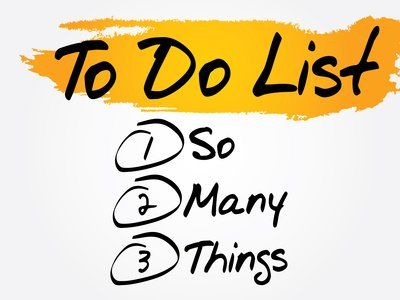The Perfect Planner’s To Do Section – How To Use It To Be Effective

A feature that is common with almost every planner is the notes or task list section. Marrying the task list with the calendar is an important time management feature of planners – it’s what separates planners from plain calendars. Seeing what needs to be done next to the calendar makes time management a bit more concrete. After all, stuff doesn’t get done in a vacuum. You need to consciously find the time to take care of your tasks. Ideally there should be an area to write the tasks for each day. The benefit of a small daily task area is that it forces you to focus on the most important tasks of the day. After the initial tasks are done, you can always add to your tasks by putting a sticky note with additional tasks atop the daily task list. A planner with a large task area accommodates large handwriting and lots of notes. Planners with one or two pages per day provide the largest task and note areas. However, by focusing on the details of one day, the deadlines and overall goals for the week may not be as apparent as they are with a weekly or monthly view. Regardless of which calendar view is used (daily or weekly), it is important to keep the overall deadlines and goals in mind when drawing up the daily task list. This brings me to the next feature: the master to do list.
The master to do list is an organized list of everything that needs to get done. The list is organized by contexts – more on that later. Ideally, the master list is reviewed and worked on at least once a week. In fact, I find not reviewing the master to do list is the undoing of many people’s time management strategies. It takes about ten minutes to review the master list – that’s all! Because the review is so important, don’t leave it to happenstance – schedule it. I find Sunday evening is a great time for the review.
During the review you will add items to your master to do list, prioritize items and remove items. In the process of prioritizing, you will identify the top items that need to be addressed in the upcoming week. I think it’s a good idea to write down the weekly priorities in the calendar section of the planner so that you can see them when you check your agenda. Certainly there will be urgent things that crop up during the week that will land on your daily to do list; however, keep the focus on what’s important by basing the each day’s to do list on the weekly goals.
You can create the master to do list in a couple of steps.
The first step is to write down everything that needs to be done without regard to priority. Where does this stuff come from? Your email, your physical mail, notes from meetings, randomly collected notes and notes in your planner are the common sources of to dos. Use a scratch piece of paper and once you’ve captured everything, you can then organize the list into contexts in the planner – the second step.
One strategy to organize your list is by the type of action required. Organizing items by action is helpful for when you want to batch similar tasks. It can be very efficient to make several phone calls, pay several bills, or run several errands in a specific time frame. A second strategy is by your different responsibilities – I call this “organizing by hats.” Some of the “hats” that I wear are: mom, organizer, Boy Scout Leader and personal. By personal, I mean the things that I want to do that are for me alone. The final organizing strategy that I will mention is to list tasks by your goals. Use as few or as many organizing strategies that make sense to you; however, keep things as simple as possible. Remember the point of organizing your to do items is to make it easy to actually get things done. Do not omit the organizing step. Without organization, there is no priority.
A benefit of keeping the master to do list in your planner is that the list will be easy to find. An easy-to-find list is more likely to be reviewed and have tasks worked on. A list kept in the planner is less likely to be lost. The weekly review process offers the opportunity to distill what needs to be done each week so that your efforts are focused and effective.
To review:
- Create a master to do list by:
- Writing down everything that needs to be done on scratch paper,
- Organize those tasks into contexts – only to the point of making them manageable, and
- Keep the organized list in your planner.
- Review the master to do list at least once a week (10 minutes – schedule it!).
- Edit the list – add, tweak and remove items as appropriate and don’t be afraid to reorganize it if it makes it more manageable.
- Pull out a few important items to work on during the upcoming week and write these down in a separate weekly list.
- Keep the weekly list in the calendar section of the planner.
- Create the daily to do lists based on what is on the weekly list as well as what crops up during the course of the week.
The whole process from capturing everything that you have to do and turning it into your daily to do list is one of distillation. While going through the distillation steps may seem like a lot of work, consider how much effort is expended in creating and recreating lost lists, forgetting tasks and then scrambling to get them done, never having the time to work on your goals, or completing tasks late. Distillation gives you the ability to be focused, effective and agile in your efforts and actually get things done.










